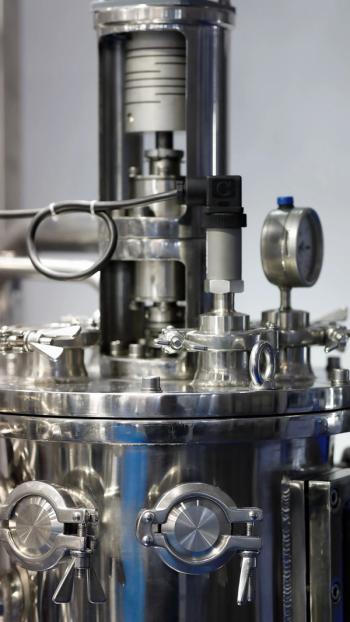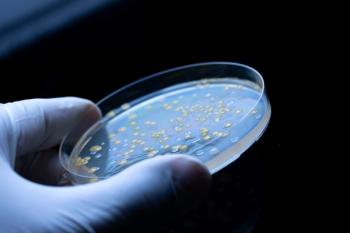
- Pharmaceutical Technology-02-02-2014
- Volume 38
- Issue 2
Determination of Related Substances in Pemetrexed Disodium (Form-IV) in Bulk Drug Samples by HPLC
The authors describe the development of a stability-indicating reverse-phase high-performance liquid chromatographic (RP?HPLC) method for the quantitative determination of potential genotoxic impurities present in pemetrexed disodium (form-IV). The chromatographic separation was achieved on a RP?HPLC column (Zorbax SB-Phenyl, Agilent) at ambient temperature with gradient elution using mobile phase A (trifluoroacetic acid [TFA] in water) and mobile phase B (TFA in acetonitrile).
Pemetrexed is an anticancer drug indicated in the treatment of pleural mesothelioma as well as non small cell lung cancer (1). Its chemical structure is shown in Figure 1. It is a folate analog metabolic inhibitor that exerts its action by disrupting folate dependent metabolic processes essential for cell replication. In-vitro studies have shown that pemetrexed inhibits thymidylate synthase, dihydrofolate reductase, and glycinamide ribonucleotide formyltransferase, which are folate-dependent enzymes involved in the de-novo biosynthesis of thymidine and purine nucleotides (2-4).
The literature reports only a few high-performance liquid chromatographic (HPLC) methods for determination of pemetrexed disodium and its metabolites in biological fluids (5-9). Genotoxicity refers to any deleterious change in the genetic material regardless of the mechanism by which the change is induced. Genotoxic impurities are defined as an impurity that has been demonstrated to be genotoxic. Detection, quantitation, and control of potentially genotoxic impurities to very low levels below the identification threshold presents considerable challenges for synthetic and analytical chemists in the development, manufacture, and control of API, impurities in the API, and the drug product. The aim of this study was to develop and validate a rapid, economical, and sensitive HPLC method for the determination of related substances in pemetrexed disodium (form-IV) in bulk drug samples. A robust, rapid, sensitive, and validated analytical method is needed for day-to-day analysis, in routine analysis in quality control laboratories of the drug in bulk drug samples, and which can be applicable for pharmaceutical dosage forms.
Materials and method
Chemicals and reagents. Pemetrexed disodium (form-IV) bulk drug (99.79% purity) and genotoxic impurities end product by product EPBP-2 (85.84% purity), EPBP-3 (98.49% purity), EPBP-5 (87.98% purity), and intermediate IM-7 (99.69% purity) were provided by R&D Lab, Neuland Pharma Research Private Limited. Acetonitrile (HPLC grade) and trifluoroacetic acid (TFA) (HPLC grade) were obtained from Merck, India.
Instrumentation. The HPLC system consisted of a Waters 2695 HPLC system separation module with Waters 2487 dual-wavelength absorbance detector. Data acquisition was performed by Empower Alliance software. The method is a gradient reverse-phase HPLC, which employs a reversed-phase column (250 x 4.6 mm, 5.0 μm, Zorbax SB-Phenyl, Agilent) with mobile phases A and B at ambient temperature. Mobile phase A consisted of 0.03% TFA in degassed and filtered Milli-Q water. Mobile phase B consisted of 0.025% TFA in degassed and filtered acetonitrile. The analysis was performed at a wavelength of 228 nm using a dual wavelength absorbance detector. The sample concentration was 1.0 mg/mL and injection volume was 5 µL with a run time of 40 min.
Method development and optimization. Pemetrexed disodium (form-IV) is soluble in water. The drug can be separated on a reverse-phase column (Zorbax SB-Phenyl, Agilent). The optimization of the method development was done by gradient elution. The following gradient program was developed during method development (see Table I).
Table I: Gradient program for separation of pemetrexed disodium (form-IV).
Time (minutes)
Flow(mL/min)
Mobile phase A (%)
Mobile phase B (%)
0
1.0
90
10
3
1.0
90
10
12
0.5
75
25
20
0.5
75
25
25
0.5
70
30
30
1.0
70
30
32
1.0
20
80
35
1.0
20
80
37
1.0
90
10
40
1.0
90
10
To prepare 0.1M sodium acetate solution, approximately 3.402 g of sodium acetate was weighed and transferred into a 250-mL volumetric flask containing water, and the volume was made up with water. Pemetrexed disodium (form-IV) standard solution was prepared by dissolving 25 mg of pemetrexed disodium (form-IV) standard in a 25-mL volumetric flask, and the volume was made up with the diluent. The diluent was acetonitrile and water in a 1:1 ratio. Pemetrexed disodium (form-IV) sample solution was prepared by dissolving 25 mg of the pemetrexed disodium (form-IV) sample in a 25-mL volumetric flask, and the volume was made up with the diluent.
EPBP-2 impurity solution was prepared by dissolving 10 mg of EPBP-2 impurity in a 100-mL volumetric flask and the volume made up with the diluent. EPBP-3 and EPBP-5 impurity solutions were prepared by dissolving 10 mg of EPBP-3 and EPBP-5 impurities respectively in a 100-mL volumetric flask and the volume made up with the diluent.
IM-7 impurity solution was prepared by dissolving 10 mg of IM-7 impurity in a 100-mL volumetric flask containing 95.0 mL of 0.1 M sodium acetate solution and 5.0 mL of acetonitrile.
The peak shapes and symmetry of pemetrexed disodium (form-IV) and impurities were acceptable with the gradient elution method. Pemetrexed disodium (form-IV) and impurities peaks were resolved with a resolution greater than 1.5 at a gradient flow rate. The method developed could determine related impurities at lower levels than the specification limit of not more than 0.10% with respect to the test concentration of 1.0 mg/mL. The developed method was successfully applied to estimate the amount of pemetrexed disodium (form-IV) related impurities.
Method validation. The system suitability was assessed by duplicate analysis of the drug, which was spiked with all impurities at a concentration of 0.1% with respect to the test concentration of 1.0 mg/mL. The acceptance criteria were that the resolution between IM-7 and EPBP-3 should not be less than 1.5 and the tailing factor for pemetrexed disodium (form-IV) peak should not be more than 1.5. The theoretical plate count of pemetrexed disodium (form-IV) should not be less than 2000.
The reference solution for impurities quantification was assessed by the six replicate injections of all four impurities and a standard at a concentration of 0.1% with respect to the test concentration of 1.0 mg/mL. The acceptance criteria were that the % relative standard deviation (RSD) for the peak area of each component should not be more than 5.0.
The limit of detection (LOD) and limit of quantification (LOQ) were determined by calculating the signal-to-noise (S/N) ratio followed by comparison of test results from samples with known concentrations of analyte with those of blank samples. By the approach described, the minimum level at which the analyte can be reliably detected was established. The LOD and LOQ of the impurities and sample were determined by preparing 0.1% of reference solution. Approximately 5 µL of solutions were injected into the chromatographic system and the S/N ratio was calculated using the following equation:
The S/N ratio should be established to approximately 3:1 for LOD and approximately 10:1 for LOQ.
Linearity is the ability of the method to elicit test results that are directly proportional to analyte concentration within a given range. A series of seven solutions at concentrations of the LOQ, 25%, 50%, 75%, 100%, 125%, and 150% were prepared using the impurities standard stock solutions. Linearity of the method was demonstrated. The target concentration was 0.1% for these solutions with respect to the test concentration 1.0 mg/mL. Approximately 5.0 µL of each of the prepared solutions were injected into the chromatographic system and measured for six times at levels 1, 5, and 7 and for three times at levels 2, 3, 4, and 6. The average peak area response was calculated. A plot of data was established for analyte response versus concentration. The degree of linearity was estimated by calculating the regression coefficient (R2), % of Y-intercept, residual sum of squares, and Y-intercept/response at 100% of working concentration.
The acceptance criteria were that the system suitability criteria should be met and % RSD for area of impurities should not be more than 5.0. The % RSD for the peak area of all components in the reference solution should not be more than 5.0. The regression coefficient for each impurity should not be less than 0.99 and % of Y- Intercept should be ± 5.0.
Accuracy and precision. The accuracy of an analytical method expresses the closeness of agreement between the value that is accepted either as a conventional true value or an accepted value and the value found. Accuracy was calculated with respect to the prepared solution at the levels of the LOQ, 25%, 50%, 75%, 100%, 125%, and 150% of the limit concentration of 0.1% with respect to the test concentration 1.0 mg/mL. The accuracy of the method was demonstrated through a recovery experiment on samples at concentration level of the LOQ to 150%, and the recovery was calculated in each of the case using Equation 2.
The acceptance criteria were that the % of recovery for the LOQ % solution should be 100 ± 20 and % of recovery for the 25-150% solutions should be 100 ± 15.
Precision of the method was demonstrated under three categories.
- System precision. A single individual preparation of pemetrexed disodium (form-IV) drug substance was prepared with target concentration of approximately 1.0 mg/mL spiked with 0.1% of all known impurities for system precision. Six replicate injections of the preparation, each approximately 5.0 µL, were injected into the chromatographic system and the chromatograms were recorded. The RSD for the peak area and content of all four impurities from replicate injections were calculated.
- Method precision. Six individual preparations of pemetrexed disodium (form-IV) drug substance were prepared with target concentration of 1.0 mg/mL spiked with 0.1% of all known impurities. Approximately 5.0 µL of the preparations were injected into the chromatographic system and the chromatograms were recorded. The RSD for the peak area and content of all four impurities of the six different preparations were calculated.
- Intermediate precision (ruggedness). The ruggedness of an analytical procedure is a measure of its capacity to remain unaffected by intra-laboratory variations. It provides an indication of the method’s reliability during normal usage. Demonstration of ruggedness was conducted by different analysts, on different systems and columns, and on different days under similar conditions at different times. Six individual preparations of pemetrexed disodium (form-IV) drug substance were prepared with target concentration of about 1.0 mg/mL spiked with 0.1% of all known impurities and each were analyzed (see Figure 2).
The acceptance criteria for system, method, and intermediate precision were that the system suitability criteria should be met and the % RSD for the peak area of each component in the reference solution from the six replicate injections should be not more than 5.0%. The % RSD for the content of each impurity should not be more than 5.0 and the cumulative % RSD for the content of each impurity obtained from the ruggedness study and method precision should not be more than 10%.
The robustness of an analytical procedure is a measure of its capacity to remain unaffected by small, but deliberate variations in method parameters and provides an indication of its reliability during normal usage. Two parameters of the method (i.e., flow rate and wavelength of detection) were challenged at both lower and higher levels of the normal operational standard conditions (method precision conditions) and the analytical results of all the analytes of interest were evaluated. Six individual preparations of pemetrexed disodium (form-IV) drug substance were prepared with target concentration of about 1.0 mg/mL spiked with 0.1% of all known impurities and each were analyzed. The parameters selected with their higher and lower tested values are shown in Table II.
Table II: Tabulated representation of robustness
Parameter tested
Method precision (standard conditions)
Lower value than standard conditions
Higher value than standard conditions
Flow rate (mL/min)
1.0
0.9
1.1
Wavelength (nm)
228
226
230
The acceptance criteria for system, method, and intermediate precision were that the system suitability criteria should be met and the % RSD for the peak area of each component in the reference solution from the six replicate injections should be not more than 5.0%. The % RSD for the content of each impurity should not be more than 5.0% and the cumulative % RSD for the content of each impurity obtained from the robustness study and method precision should not be more than 10%.
The validity of the solutions was demonstrated for a period of 24 hours by injecting the same solution at periodic intervals into the chromatographic system and the chromatograms were recorded. The peak areas of related impurities in pemetrexed disodium (form-IV) were observed and the RSD for the content of related impurities were calculated. The acceptance criteria were that the system suitability should pass as per the test method at variable conditions and % RSD for the peak area of each component in the reference solution should not be more than 5.0%. The % RSD for the content of each impurity should not be more than 5.0% and the cumulative % RSD for the content of each impurity obtained from the solution stability study and method precision should not be more than 10%.
The specificity of the method was demonstrated by interference check by injecting the diluent blank, pemetrexed disodium (form-IV), and impurities solutions to determine that there should not be any interference of blank peaks with EPBP-2, EPBP-3, EPBP-5, IM-7, and pemetrexed disodium (form-IV) peaks.
Results and discussion
The chromatograms for pemetrexed disodium (form-IV) are shown in Figures 3 and 4. The resolution between IM-7 and EPBP-3 was not less than 1.5, the number of theoretical plates was not less than 2000, and tailing was not more than 1.5 for pemetrexed disodium (form-IV) peaks (see Table III and Figure 5). In terms of system suitability for quantification, the % RSD for peak area of EPBP-2, IM-7, EPBP-3, EPBP-5, and pemetrexed disodium (form-IV) peaks were not more than 5.0% (see Table IV and Figure 6).
Figure 3: Blank chromatogram of pemetrexed disodium (form-IV).
Figure 4: Chromatogram of pemetrexed disodium (form-IV) sample.
Table III: System suitability study of pemetrexed disodium (form-IV). IM is intermediate. EPBP is end product by product.
Retention time (min)
Resolution between
IM-7 and EPBP-3
Theoretical plate count
Tailing factor
Pemetrexed disodium (form-IV)
IM-7
EPBP-3
Injection-1
19.591
24.084
24.774
1.91
118072
1.19
Injection-2
19.572
24.061
24.750
1.91
117830
1.19
Average
19.582
24.073
24.762
1.91
117951
1.19
Figure 5: System suitability for pemetrexed disodium (form-IV). EPBP is end product by product. IM is intermediate.
Table IV: System suitability for quantification study of pemetrexed disodium (form-IV). EPBP is end product by product. IM is intermediate.
Name of the component
Area
EPBP-2
Pemetrexed
disodium (form-IV)
IM-7
EPBP-3
EPBP-5
Concentration (mg/mL)
0.001
0.001
0.001
0.001
0.001
Injection-1
15270
35327
46114
32397
15887
Injection-2
15335
35512
45939
32205
16124
Injection-3
15374
35491
45629
32208
16029
Injection-4
15548
35530
45891
32535
16152
Injection-5
15537
35375
45690
32416
16387
Injection-6
15693
35900
46046
32431
15756
Average
15460
35523
45885
32365
16056
% relative standard deviation
1.03
0.57
0.42
0.41
1.37
Figure 6: System suitability for pemetrexed disodium (form-IV). EPBP is end product by product. IM is intermediate.
The detection limits for all known impurities and pemetrexed disodium (form-IV) were < 0.003% with a S/N ratio of approximately 3. The quantitation limits for all known impurities and pemetrexed disodium (form-IV) were < 0.01 % with a S/N ratio of approximately 10 (see Table V).
Table V: Limit of detection (LOD) and limit of quantification (LOQ) values of pemetrexed disodium (form-IV) and its related impurities. EPBP is end product by product. IM is intermediate.
Name of the component
Signal-to-noise ratio
EPBP-2
Pemetrexed
IM-7
EPBP-3
EPBP-5
LOD
LOQ
LOD
LOQ
LOD
LOQ
LOD
LOQ
LOD
LOQ
Concentration (%) with respect to test
0.0027
0.0090
0.0011
0.0035
0.0015
0.0050
0.0024
0.0080
0.0026
0.0085
Injection-1
3.03
10.94
3.69
9.31
3.38
10.08
2.62
10.08
3.01
10.48
Injection-2
3.03
10.98
3.10
9.50
3.05
10.33
2.63
10.16
3.19
11.27
Injection-3
2.88
10.72
3.72
9.56
2.61
10.91
2.29
10.34
3.17
10.55
Average
2.98
10.88
3.50
9.46
3.01
10.44
2.51
10.19
3.12
10.77
Figure 7: Calibration curves of known impurities.
Table VI: Regression statistics of impurities. EPBP is end product by product. IM is intermediate.
Name of impurity
EPBP-2
IM-7
EPBP-3
EPBP-5
Intercept
-389.14
-232.43
-420.53
97.36
% of Y-intercept
-2.53
-0.50
-1.44
0.60
Multiple R
0.9992
0.9997
0.9990
0.9996
R square
0.9984
0.9993
0.9980
0.9992
Confidence intervals
EPBP-2
IM-7
EPBP-3
EPBP-5
Lower 95%
Upper 95%
Lower 95%
Upper 95%
Lower 95%
Upper 95%
Lower 95%
Upper 95%
Intercept
-1065.91
287.64
-1524.20
1059.33
-1853.07
1012.00
-368.79
563.51
X variable 1
155219.94
170225.61
461153.50
489808.85
290429.17
322196.42
158358.49
168694.87
Figure 8: Residual plots of known impurities. EPBP is end product by product. IM is intermediate.
Table VII: % recovery of known impurities of pemetrexed disodium (form-IV). EPBP is end product by product. IM is intermediate.
Accuracy (% of recovery studies)
Name of impurity
Limit of quantification
25%
50%
75%
100%
125%
150%
EPBP-2
100.83
100.21
99.98
101.74
102.46
107.52
107.14
IM-7
100.31
99.51
103.94
102.19
100.81
103.04
104.01
EPBP-3
109.14
98.35
102.92
102.77
100.46
102.46
106.62
EPBP-5
108.15
98.48
106.79
103.23
100.77
101.62
102.70
The linearity of the calibration curve constructed was evaluated by its coefficient of determination (see Figure 7) and the regression statistics of impurities (see Table VI). Residual plots were constructed in the form of scatter plot to determine whether or not linear regression is appropriate for the data. The residuals fall randomly around the x-axis, indicating the linear relationship between independent and dependent variables (see Figure 8).For the accuracy study, the % of recovery for the content of all known impurities were found to be in the range of 98%-110% (see Table VII).
Range is the interval between the upper and lower levels of the analyte that has been demonstrated to be determined with precision, linearity, and accuracy using the method. The ranges for all known impurities of pemetrexed disodium (form-IV) [EPBP-2, IM-7, EPBP-3, and EPBP-5] were established by linearity and accuracy studies to be at the LOQ to 150% level (see Table VIII).
Table VIII: Range of known impurities of pemetrexed disodium (form-IV). EPBP is end product by product. IM is intermediate.
Name of impurity
Lower range (%)
Upper range (%)
EPBP-2
0.0090
0.150
IM-7
0.0050
0.150
EPBP-3
0.0080
0.150
EPBP-5
0.0085
0.150
For the system precision study, the % RSD for the content (%) of all known impurities were found to be in the range of 0.45-1.80. In terms of method precision, the % RSD for the content (%) of all known impurities were found to be in the range of 0.50-2.40. For the intermediate precision study, the % RSD for the content (%) of all known impurities were found to be in the range of 1.50-2.60 and the cumulative % RSD of all known impurities with method precision were found in the range of 1.7-2.0.
The data from method precision was considered for Day-1/Analyst-1/Column-1/System-1 and the data from intermediate precision was considered for Day-2/Analyst-2/Column-2/System-2. The cumulative % RSD for the content (%) of all known impurities obtained from ruggedness study and method precision are shown in Table IX was as follows.
Table IX: Comparative results of precision and ruggedness study. EPBP is end product by product. IM is intermediate.
Sample number
Content (%) of impurity
Day-1/Analyst-1/Column-1/System-1
Day-2/Analyst-2/Column-2/System-2
EPBP-2
IM-7
EPBP-3
EPBP-5
EPBP-2
IM-7
EPBP-3
EPBP-5
Preparation-1
0.0966
0.0990
0.0973
0.0982
0.0966
0.1018
0.1003
0.1005
Preparation-2
0.0987
0.0985
0.0987
0.0970
0.0996
0.1000
0.0979
0.0972
Preparation-3
0.1008
0.0997
0.0978
0.0987
0.0984
0.0978
0.0975
0.0973
Preparation-4
0.1014
0.0990
0.0989
0.0989
0.0985
0.0967
0.0945
0.0949
Preparation-5
0.1000
0.0994
0.0987
0.0982
0.0995
0.0958
0.0955
0.0955
Preparation-6
0.1034
0.0997
0.0997
0.0981
0.1011
0.0953
0.0943
0.0951
Average
0.1002
0.0992
0.0985
0.0982
0.0989
0.0979
0.0967
0.0967
%RSD
2.34
0.46
0.85
0.67
1.52
2.57
2.41
2.18
Cumulative %RSD for the content of impurities
Name
EPBP-2
IM-7
EPBP-3
EPBP-5
%RSD
1.99
1.90
1.98
1.71
The robustness study was performed by OFAT (one factor at a time) approach. The most significant method parameters/factors considered were flow rate and wavelength. The deliberate changes at ± 10% variation from the actual method for flow rate and ± 2 nm for wavelength were studied. The cumulative % RSD for the content of known impurities was found to be less than 10%.
The stability of standard solutions, test sample solution, and mobile phases were studied. It was found that the mobile phases were stable for 48 hours and the standard solutions were stable for 24 hours.
Conclusion
A simple gradient RP-HPLC method was developed and validated for related substances in pemetrexed disodium (form-IV) in bulk drug samples. The method was validated according to the International Conference on Harmonization (ICH) Q2 (R1) guidelines for system suitability, accuracy, precision, linearity, specificity, solution stability, robustness, and ruggedness, LOD and LOQ (10). Pemetrexed disodium (form-IV) was analyzed by using Zorbax SB-phenyl column (250 mm x 4.6 mm, 5 μm) at ambient temperature with gradient elution. The analysis was performed at a wavelength of 228 nm using a UV-Vis detector. The retention time for pemetrexed disodium (form-IV) was approximately 19.6 min. The obtained calibration curves were linear over acceptable concentration across the range. The LOD for impurities in pemetrexed disodium (form-IV) was < 0.003% and the LOQ was < 0.01%. The method developed was unique in determining the impurities even at lower levels than that of specifications. The developed method was successfully applied to estimate the content of impurities in pemetrexed disodium (form-IV). The proposed HPLC method is precise, sensitive, accurate, specific, and efficient and can be used in routine analysis in quality control laboratories.
References
- Merck Manual, “
Lung Carcinoma ,” accessed Jan. 7, 2014. - J.R. Schnell, H.J. Dyson, P.E. Wright, Annual Review of Biophysics and Biomolecular Structure, 33 (1) 119-40 (2004).
- H.L. McLeod et al., Clinical Cancer Research, 6 (7) 2677-84 (2000).
- C. Avendano and J.C. Menendez, “Chapter 2: Antimetabolites” in Medicinal Chemistry of Anticancer Drugs, C. Avendano and J.C. Menendez, Eds., pp. 9-52 (Elsevier, April 2008).
- L.P. Rivory et al., J Chromatogr B, 765 (2) 135- 40 (2001).
- C Bobin-Dubigeon et al., J Chromatogr B, 877 (24) 2451-56 (2009).
- L.G. Mendelsohn et al., Adv Enzyme Regul, 36: 365-381 (1996).
- D.A. Rinaldi et al., Cancer Chemother Pharmacol, 44 (5) 372-380 (1999).
- C.L. Hamilton and J.A. Kirkwood, J Chromatogr B Biomed Appl, 654 (2) 297-303 (1994).
- ICH, Harmonized Tripartite Guideline on Validation of Analytical Procedures: Text and Methodology Q2(R1), Step 4 version (2005).
Articles in this issue
almost 12 years ago
FDA Focuses on Drug Appearance and Attributesalmost 12 years ago
Turkey Increases R&D Incentivesalmost 12 years ago
EMA Collaborates with HTA Assessment Networksalmost 12 years ago
Novel Expression Systems Opening CMO Opportunitiesalmost 12 years ago
Pulmonary Drug Delivery—Particle Engineering for Inhaled Therapeuticsalmost 12 years ago
Defining Quality Metrics is No Easy Taskalmost 12 years ago
More Rapid Extractable & Leachable Analyses with Advanced Mass Spectrometersalmost 12 years ago
Content Packages Accelerate MBR CreationNewsletter
Get the essential updates shaping the future of pharma manufacturing and compliance—subscribe today to Pharmaceutical Technology and never miss a breakthrough.




